Matching Points + Power, by Jordy Smith
Words by Jordy Smith Point breaks are the best kind of waves to improve your technical surfing. New Pier, where I grew up surfing, is basically a sand-bottom point. When the sand pumps it builds up in front of the piers, and with a lot of our swells, gets moulded into a right point. I […]
Words by Jordy Smith
Point breaks are the best kind of waves to improve your technical surfing. New Pier, where I grew up surfing, is basically a sand-bottom point. When the sand pumps it builds up in front of the piers, and with a lot of our swells, gets moulded into a right point. I went to Jeffreys Bay for the first time when I was seven, and at that moment, I just loved the fact that the wave never closed out. The amateur contests were all based around a lot of the pointbreaks, so that shaped the majority of South African surfers into pointbreak surfers. It’s a big advantage when you can get onto the open face every wave and practise some turns.
01 | First surf, new point
You can try and study a new point all you want before paddling out, but your best bet is just to get out there and feel it out. Before I even take off on a wave at a new spot, I don’t overthink it. I’ll go out with a completely open mind and I’ll just have a surf. After my first session I’ll come back in and ask myself, “What was I lacking out there?” Don’t judge the wave before you’ve even ridden it. I’ll go out first, analyse what was hardest for me, and go from there.
02 | Spotting the paddle out location
Deciding where to paddle out at a point is a matter of people-watching. Take a few minutes to see where everyone’s jumping out, and take note. The majority of the time you pull up to a spot, there’ll be a few guys out. It’s all about picking the safest option, and whatever’s going to get you out there the quickest. It’ll most likely be a finger of rock or a keyhole to Also, know where you’re going to come in, before you paddle out!
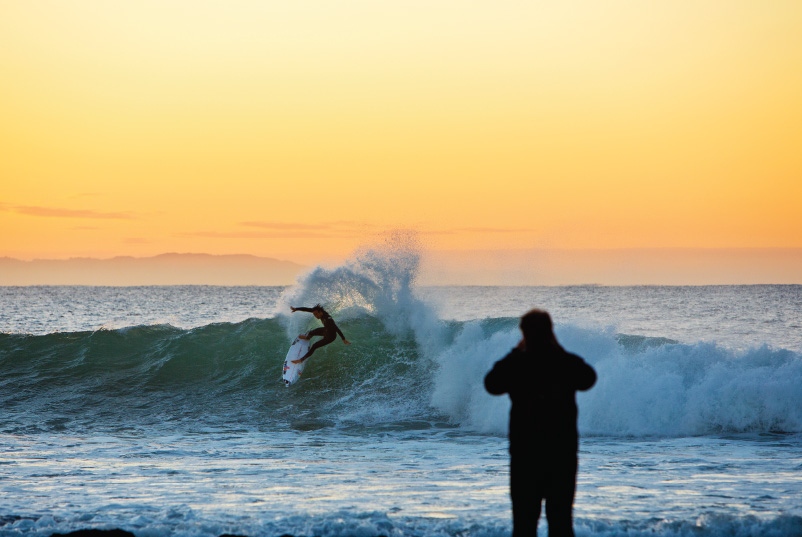
The sparing partner, J-Bay. Photo by Alan Van Gysen
03 | The rock-off
You’re guaranteed to cop a couple of beatings rocking off. The worst beating was when I was 15 at Snapper Rocks. I had a brand new board, new fins, all waxed up and ready to go. I stood up on the rock at Snapper, went to jump and this wave hit me straight in the head. I’d completely mistimed the jump. It threw me all over the rocks. I cut all of my stomach, my back and legs, everywhere. I actually fell off the other side into the keyhole, came up and my whole board was wrecked. I had blood coming out of everywhere and needed stitches. Both fins were missing, so I couldn’t even go out and try and ride a wave down to Kirra. I had to walk back, head down, bleeding, and extremely bummed. Things like that just make you have better judgment. Time your skip out to the edge of the rock in between sets. Wrap the excess length of your legrope up into your hand to avoid getting caught on any sharp hooks. You want to jump from the rock onto the back of the incoming wave, and get paddling. Quick. You don’t want to be pinned up against a point when a set comes, all because you mistimed your leap.
04 | Choosing your spot
Once you’re in the line-up, make a conscious decision to mix up where you sit on the point. Waiting deep out the back might work sometimes, but often the waves that sneak under everyone stand up and run down the point better. At Snapper, there are guys that can take off behind the rocks, and then there are guys that will take off just to the right of the judge’s tower (about 100 metres down). The majority of the time when you get one behind the rock, it doesn’t end up being the best wave. The ones that sneak underneath everyone on the inside end up being really nice, hollow and fast. Those are the exciting waves. Taj Burrow and Josh Kerr are two of the best at finding those sneaky inside waves. Keep an eye out for them on your paddle back to the top of the point. A little insider could be the wave of your session.
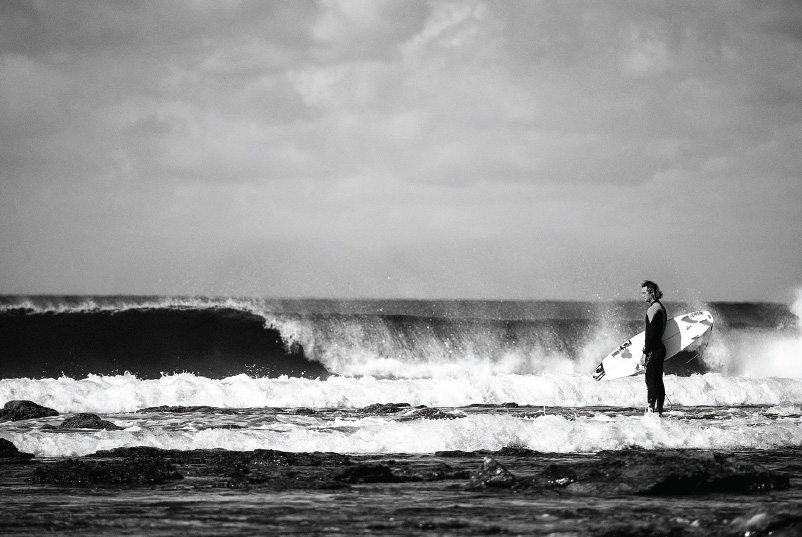
Contemplating rock-hops past. Photo by Ryan Miller
05 | Feet placement
There’s no need to stress about where your feet are on your board. Chances are you’re going to move them around from start to finish. I’ll paddle in and get up, stand on my board in my usual position and once I’ve got my speed, then I’ll drop in, swivel around and get on the tail. Some guys like to get high on their board when they come out of a turn and are going into a barrel or their next line. It’s all about personal preference and what feels right to each surfer.
06 | Speed
Once you get speed, then you can do anything. Speed’s the first manoeuvre in surfing. But when you’re on a point break it’s about being able to move at the same speed of the wave. Some waves will start out really fast and then slow down towards the end. Others will start really slow and then speed up, so it’s about choosing the right line and recognising when a section is presenting itself. You can always burn off speed by adjusting your weight back, or little kick stalls for barrel sections (see Mozambique photo on next page). But it’s harder to gain that speed once you’ve lost it after a turn. If you’ve pushed a turn too hard, watch for that section on the next wave and ease it a little. You’ll lengthen your ride considerably.
07 | Timing and patience
If you’re going to fix one thing about how you surf a point, don’t force a turn in the wrong spot. It doesn’t look good. Forcing the issue is the worst thing you can do. A lot of surfers have different approaches, but the main thing is to stay as tight as you can in the pocket. You can really mistime your first turn and then that’ll put you a split second off on your next one, and if you’re late on that one, it’ll put you two split seconds off the one after that. Points are about joining the dots. Snapper, for example, technically doesn’t allow for a big ol’ arc. But if you can do one, that’s the hardest thing; holding your rail from the top all the way to the bottom. It’s the hardest turn in surfing. Anybody can go up to the top, swivel, and cut it short, but holding your turn is extremely difficult. At point breaks like Bells and Jeffreys, you want to get out on the open face, but at a wave like Snapper, you really want to stay as close to the pocket as you can.
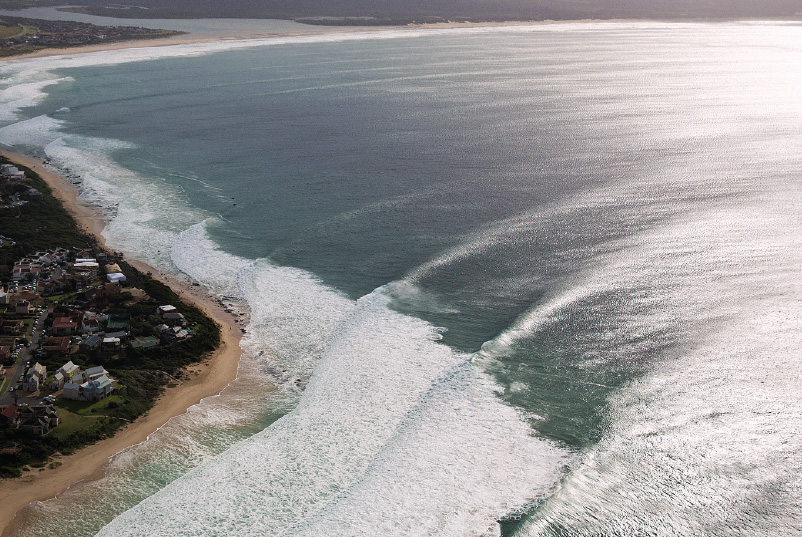
View from the bird. Photo by Alan Van Gysen
08 | It’ll always be crowded
But getting waves is about balancing patience with knowing when you’ve waited long enough. You’ve got to be courteous to the locals and to the people that are out there. But be stern when your turn comes. If it’s your turn; take it. There might be people on your inside, but you’ve got to show them that you’ve been waiting your fair share of time.
09 | But maybe, just maybe…
You’ll be lucky enough to surf a point by yourself. Pick a landmark to line up in the zone. Otherwise, rely on your feeling. It’s something you see, your ocean knowledge and the more you surf, the more attuned it gets. You feel like you’re in the right spot and everything feels good, and then, bang! There’s a wave. Glenn ‘Micro’ Hall does it really well. It’s a talent. It’s a skill in itself. In saying that, if there have been 15 great waves come through on one peak in the last hour, there’s probably going be five more good waves there in the next 30 mins. But get out there, because points are often very tidal.
10 | Equipment
The idea is to surf a pointbreak as high performance as you can. Ride a refined, performance craft. Once it starts getting to the six-to-eight foot range, then I’ll change it up to a step-up, usually two to four inches longer. There isn’t any shame in going old-school and throwing some big fins in your board either. These days you see kids get these tiny fins and they’re just flicking around. My dad put bigger fins in my board from day one and it allowed me to really come off the bottom and then come off the top without much of the double pumping and squirrely stuff. It’ll teach a kid to hold the line that they’ve drawn, and not cut it short. That will definitely carry through once they get older and a bit more powerful, that line that they’re holding will start dispersing serious water.
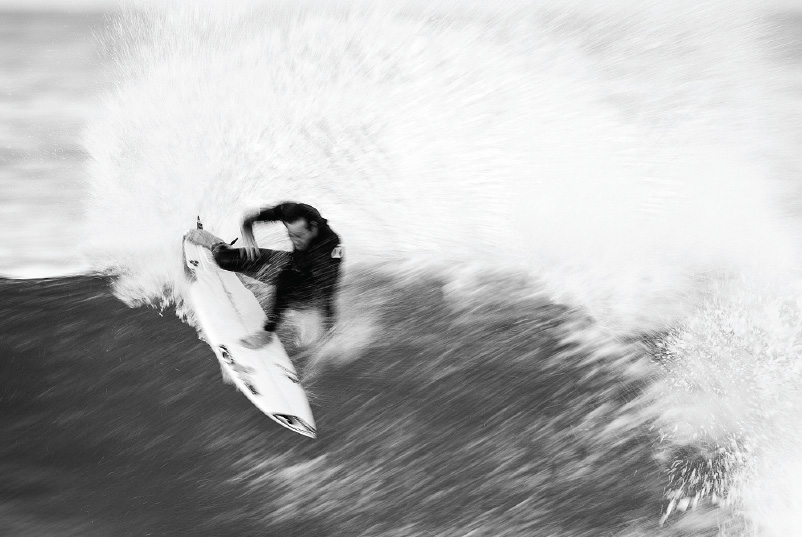
Photo by Ryan Miller
11 | Homework
Pick a surfer whose style you’re digging most because it’s the surest way to see your own point game improve. For me, first it was Taj Burrow and then Joel Parkinson. Once Joel hit the scene, it was like the smoothest surfer in the world had landed, and he was someone I could really relate to. He was an incredible surfer at J-Bay, and that was one of my goals, to be one of the best surfers there. I’d often receive comments about how I was surfing like Joel and that was really awesome. My homework was paying off. Then I got to a point in my own head where I thought, you know, if you continue to copy somebody then you can really only be as good as they are, and that changed my mindset of how I wanted to approach surfing. I really wanted to do a lot of airs and carves and just do it all.
12 | Media favourites
At a point break, I like to watch video shot straight on. It may seem pretty bland but it’s got impact and there’s no trickery or illusions created by the angles. I want to see how the guy’s board is moving. I watch the wave closely, too. Having somebody on the wave makes you think that that’s the position you’ve got to be in on that wave. But don’t underestimate watching empty waves. They’re the empty fruits for you to slice and dice whichever way you want.
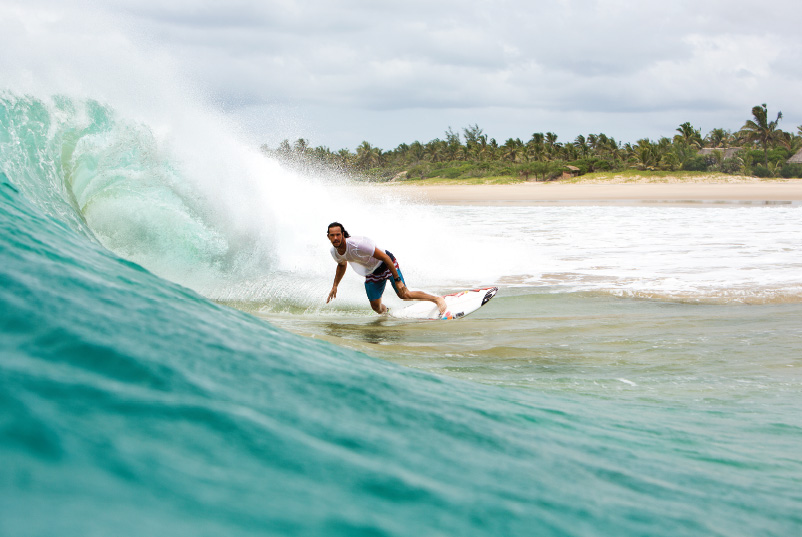
Jordy with “just a feeling” and the open track in Mozambique. Tip 9 coming to life. Photo by Alan Van Gysen





Comments
Comments are a Stab Premium feature. Gotta join to talk shop.
Already a member? Sign In
Want to join? Sign Up